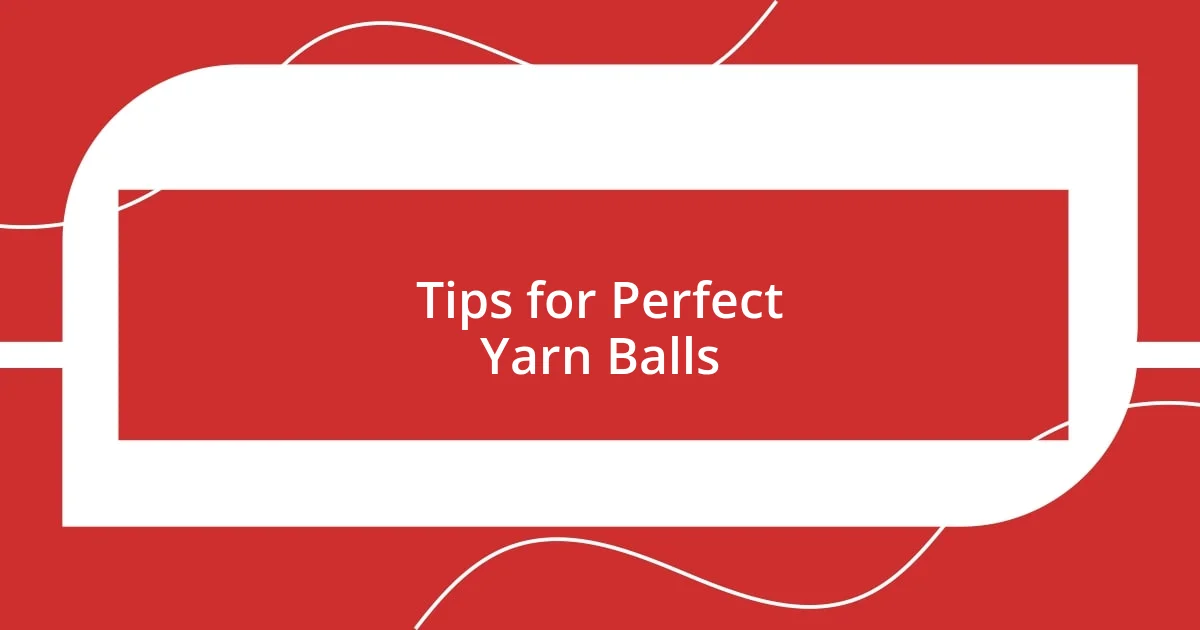Key takeaways:
- Hand winding yarn offers a tactile, meditative experience, fostering a deeper connection with the materials.
- Using tools like yarn winders and swifts enhances efficiency and helps prevent tangling, improving the overall crafting experience.
- Maintaining proper tension and using a stable surface are key to creating neat, manageable yarn balls while troubleshooting common winding issues can avoid frustration.

Understanding Yarn Winding Techniques
When it comes to yarn winding techniques, I can’t help but think of the first time I attempted to wind my yarn into a cake. I let the unwound skein get tangled, which felt like a mini disaster at the time. Have you ever experienced this? It’s surprisingly common, and understanding how to wind yarn properly can save you from that frustration.
There are several techniques to explore, but two of my favorites are the hand winding method and using a yarn winder. Hand winding is a more intimate approach, allowing me to connect with my yarn as I gently wrap it into a neat bundle. What I love about this method is the tactile experience – feeling the fibers slip through my fingers as I meticulously manage each twist. It’s almost meditative.
On the flip side, using a yarn winder can turn this chore into a delightful moment of efficiency. I recall being amazed at how quickly the winder transformed a haphazard skein into a perfect cake, ready for my next project. Have you ever wondered how this could elevate your crafting experience? It certainly made mine much smoother, allowing me to dive straight into my knitting or crocheting without the usual pre-project anxiety.

Benefits of Winding Yarn
Winding yarn brings an assortment of benefits that truly elevate the crafting experience. For instance, I’ve often found that a neatly wound skein reduces tangling, which creates a smoother knitting or crocheting process. There’s a joy in knowing that with every loop, I’m a step closer to completing my project without interruptions.
Moreover, winding yarn into a cake or ball allows me to carefully inspect each fiber, helping me identify any knots or inconsistencies before I begin. This attention to detail not only enhances the project’s outcome but also gives me a sense of connection with the materials I’m using. When I come across a hidden knot, I feel empowered, knowing I’ve caught it before it could disrupt my flow.
Lastly, the visual appeal of a well-wound yarn can’t be overlooked. As I organize my yarn, I experience a sense of satisfaction that fuels my creativity. It’s like curating a little collection of potential projects. Every time I glance at my neat rows of yarn, I can’t help but feel inspired to dive into my craft!
| Benefit | Description |
|---|---|
| Tangling Reduction | Wound yarn minimizes tangling for a smoother project experience. |
| Quality Check | Winding allows for inspection of fibers, catching issues early on. |
| Visual Appeal | Neatly wound yarn provides inspiration and satisfaction. |

Tools for Winding Yarn
When it comes to winding yarn, the right tools can make a world of difference. I remember the first time I used a swift; it felt like I had leveled up in my crafting journey. Instead of wrestling with a skein that wanted to go everywhere but where I wanted it, the swift held everything in place with grace and ease. If you’re serious about yarn winding, investing in a few key tools will change your experience dramatically.
Here are some essential tools for winding yarn:
- Yarn Winder: This device efficiently transforms skeins into tidy cakes, preventing tangling and saving time.
- Yarn Swift: It holds the skein securely while you wind, keeping tension consistent and making the process smoother.
- Ball Winder: Primarily used for creating yarn balls, it’s a compact tool that’s easy to manage and perfect for smaller projects.
- Skeins Holder: A simple yet effective solution for keeping skeins untangled while you work them into a ball or cake.
- Nostepinne: This traditional tool is great for hand winding, allowing you to create center-pull balls with a satisfying tactile exercise.
Each time I pull out these tools, I feel a sense of anticipation that builds as I prepare to bring my yarn to life. Those moments spent winding, with the soft sound of the yarn smoothly gliding through my fingers, are just as enjoyable as the projects that follow. It’s a small ritual that not only sets the stage for creativity but also fills me with appreciation for the craft.

Hand Winding Yarn Methods
Hand winding yarn can be a meditative experience for me. I recall sitting on my couch one rainy afternoon, wrapped in a cozy blanket, with my favorite music playing softly in the background. As I meticulously wound the yarn, I couldn’t help but feel a sense of calm wash over me, almost like I was reconnecting with the very essence of my craft. There’s something about the repetitive motion of winding that allows creativity to flow, turning a simple task into a sanctuary from the chaos of life.
While I usually opt for a yarn swift when I’m in a hurry, there’s a unique charm in using just my hands. I remember a time when I decided to wind an entire skein without any tools. It took longer, yes, but the experience taught me patience and gave me a deeper appreciation for the yarn itself. Each loop and twist felt personal, as if I was getting to know the fibers intimately, transforming them from a simple bundle into something ready for creation. Doesn’t connecting with your materials make the project feel even more rewarding?
In my experience, the angles of hand winding matter. Adjusting the way I hold the yarn can drastically change the tension and ease of winding. Sometimes I find myself experimenting with different methods—holding the yarn between my fingers or using my arm to guide it. These little tweaks might seem trivial, but they can significantly affect the final ball or cake, making the winding process both a practical and an explorative adventure. Have you ever felt that rush of excitement when you discover a new technique that just clicks? It’s those moments that fuel my passion for yarn crafting.

Using a Ball Winder
Using a ball winder is truly a game changer in my crafting routine. I still vividly remember the first time I set one up in my living room; the whirring sound it made as it transformed a messy skein into a perfectly round ball was music to my ears. I can honestly say that there’s a certain satisfaction in watching the yarn wind itself into a neat cake, and the whole process feels almost magical, doesn’t it?
I often find myself competing against the clock, so having a ball winder allows me to save precious time without sacrificing quality. One afternoon, while preparing for a last-minute gift, the ball winder became my best friend. Instead of getting frustrated with knots and tangles, I effortlessly churned out several cakes in a matter of minutes. Have you ever felt that rush when you realize you can streamline your projects with the right tools? It’s an exhilarating experience.
The compact design of most ball winders also makes them easy to store and transport, which I appreciate as someone who often crafts on the go. I remember taking mine to a friend’s house for a knitting marathon. As we wound our yarns together, the conversations flowed just as smoothly as the yarn, creating an atmosphere of creativity and camaraderie. Using a ball winder not only enhances efficiency but also brings an element of fun, offering a tactile joy that complements the social aspect of crafting. Don’t you just love when tools enhance both your experience and your output?

Tips for Perfect Yarn Balls
When it comes to creating perfect yarn balls, finding the right tension is essential for achieving a neat and manageable finish. I remember my first few winding attempts when my yarn ended up looking more like a lumpy mess than a tidy ball. It was a humbling experience that taught me the importance of maintaining consistent tension throughout the winding process. I discovered that holding the yarn slightly taut but not overly tight can make all the difference. Have you ever felt frustrated by a yarn ball that just won’t behave? Trust me, the right tension can turn those pesky knots into a seamless crafting experience.
An often-overlooked tip is to consider the surface on which you’re winding your yarn. I’ve noticed that winding on a stable, flat surface helps keep everything more organized. Picture this: I was once in a frenzy, winding yarn on my couch, and the fibers ended up tangled in the cushions. Ever had to climb into your furniture to retrieve your yarn? Since then, I always use a sturdy table—it gives me peace of mind. Plus, it minimizes the chances of those pesky droops that can spoil the shape of your yarn ball.
Lastly, don’t underestimate the power of practice. With each winding session, I became more attuned to the rhythm of the yarn. There’s almost a dance to it—each movement flowing into the next. I recall a day when I decided to wind yarn purely for the joy of it, not for a specific project. It felt oddly liberating and connected me deeply to my craft. Have you ever paused just to enjoy the process? Embracing that mindset transforms winding into a truly rewarding part of your creative journey.

Troubleshooting Common Winding Issues
When winding yarn, encountering tangles can be frustrating, to say the least. I remember a particularly chaotic afternoon where I lost track of time while winding a vibrant skein of merino wool. Midway, it sprang a surprise knot that felt like a metaphorical slap in the face. I quickly learned that taking a moment to gently inspect the yarn before winding can prevent this hassle. Have you ever found yourself in a similar predicament? A little care upfront goes a long way in ensuring a smooth winding experience.
Another common issue I’ve experienced is yarn slipping off the winder. This happened to me during a late-night crafting session when I was too eager to see the finished product. I recommend using a yarn guide or a simple paperclip to keep the strands from escaping. Every time I fix this, I’m reminded how a small adjustment can save a lot of time and energy. Has a little trick like this ever changed your winding game?
Lastly, if the yarn seems to be winding unevenly, it might be worth checking the alignment of your winder. There was a time when I was convinced my winder was faulty, only to realize I hadn’t secured it properly to the table. How often do we overlook these little details while getting caught up in the excitement? Ensuring the winder is stable can make the world of difference, leading to evenly wound yarn that makes me sing with joy every time I pull it from the stash. Have you felt that satisfaction of a perfectly wound ball? It truly elevates the entire crafting experience!












